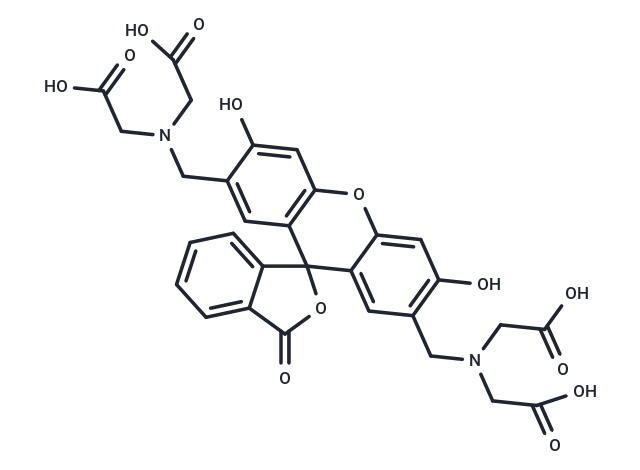Shopping Cart
Remove All Your shopping cart is currently empty
Your shopping cart is currently empty
Calcein (Fluorexon) is a fluorescent dye and self-quenching probe used as an indicator of lipid vesicle leakage, a complexometric indicator for titration of calcium ions with EDTA, and for the fluorometric determination of calcium.

| Pack Size | Price | USA Warehouse | Global Warehouse | Quantity |
|---|---|---|---|---|
| 50 mg | $35 | - | In Stock | |
| 100 mg | $47 | - | In Stock | |
| 500 mg | $105 | - | In Stock | |
| 1 g | $152 | - | In Stock |
| Description | Calcein (Fluorexon) is a fluorescent dye and self-quenching probe used as an indicator of lipid vesicle leakage, a complexometric indicator for titration of calcium ions with EDTA, and for the fluorometric determination of calcium. |
| Cell Research | Instructions I. Dissolution and preparation 1. Preparation of mother solution: Calcein is dissolved in anhydrous DMSO, ethanol or PBS. The dissolved concentration can be adjusted according to the requirements of the experiment, usually in the range of 1-10 mM. 2. Preparation of working solution: When used for cell staining, the dissolved Calcein is added to the cultured cells, usually at a concentration of 1-5 μM (the specific concentration needs to be optimized according to the experiment). II. Cell staining 1. After adding Calcein, the cells usually need to be incubated at 37°C for 30 minutes to 1 hour. 2. After labeling, it can be analyzed using a fluorescence microscope or flow cytometer. 3. Calcein dye enters the cell through the permeability of the cell membrane. In the presence of calcium ions, it binds to calcium ions and emits green fluorescence. III. Lipid vesicle leakage detection Calcein can be used to evaluate the integrity of the cell membrane in lipid vesicle leakage experiments. When the lipid vesicle membrane is damaged, Calcein leaks out of the vesicle, resulting in changes in the fluorescence signal. Therefore, it can be used as an indicator for detecting membrane leakage and membrane stability. IV. Calcium ion titration and determination: 1. Calcein can also be used as an indicator for EDTA calcium ion titration and fluorescence determination of calcium ions. Calcein binds to calcium ions to form a fluorescent complex, so by measuring the fluorescence intensity, the concentration of calcium ions in the solution can be inferred. 2. In the calcium ion determination experiment, the fluorescence intensity of Calcein is linearly related to the concentration of calcium ions, and can usually be detected under the condition of absorption/emission spectra of 490/515 nm. V. Removal of background signal When performing fluorescence imaging or flow cytometric analysis, appropriate washing steps can be used to remove unbound Calcein dye on the cell surface or in the culture medium to reduce background fluorescence. Notes: 1. Calcein solution should be stored at -20°C and protected from light. 2. Avoid repeated freezing and thawing to maintain its fluorescence stability. |
| Synonyms | Fluorexon |
| Molecular Weight | 622.53 |
| Formula | C30H26N2O13 |
| Cas No. | 1461-15-0 |
| Smiles | OC(=O)CN(CC(O)=O)Cc1cc2c(Oc3cc(O)c(CN(CC(O)=O)CC(O)=O)cc3C22OC(=O)c3ccccc23)cc1O |
| Relative Density. | 1.74 g/cm3 |
| Color | Yellow |
| Appearance | Solid |
| Storage | keep away from direct sunlight | Powder: -20°C for 3 years | In solvent: -80°C for 1 year | Shipping with blue ice/Shipping at ambient temperature. | ||||||||||||||||||||||||||||||||||||||||
| Solubility Information | DMSO: 100 mg/mL (160.63 mM), Sonication is recommended. H2O: 5 mg/mL (8.03 mM), when pH is adjusted to 12 with NaOH. Sonication is recommended. 1M NaOH: 81.67 mg/mL (131.19 mM), Sonication is recommended. | ||||||||||||||||||||||||||||||||||||||||
Solution Preparation Table | |||||||||||||||||||||||||||||||||||||||||
H2O/1M NaOH/DMSO
1M NaOH/DMSO
| |||||||||||||||||||||||||||||||||||||||||
| Size | Quantity | Unit Price | Amount | Operation |
|---|

Copyright © 2015-2026 TargetMol Chemicals Inc. All Rights Reserved.